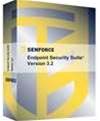For: An easy to install centralized application that provides many layers of security protection to the most vulnerable devices on a network — the clients. It also provides the ability to restrict access to wireless devices and to block usage of USB hard drives.
Against: The overall lack of documentation makes the job of configuring the first system difficult.
Verdict: A product with many features that provides

The configuration of the EES application allows the administrator to lock the system down to only attached-to access points (no Ad-Hoc connections) on an approved list. The ESS offering can also deny access to the wireless interface while the wired connection is active.
In addition, all wireless interfaces on the client can be disabled, and ESS can require a minimum set of security features to be met on both the client and access point in order for a connection to be established.
The application is broken into two pieces — the Senforce security client, which provides the enforcement of the policy on the client, and the Senforce policy builder, which provides the security policy to which the client will have to adhere.
In the server offering, a central log management component is provided, as well as tools to push the configuration out from the Senforce server to multiple clients on the network. The Senforce policy builder does require the .net version 1.1 and SQL server version 2005. Once the policy builder is installed, the layout is easy to understand and building policies is relatively easy.
Senforce provided little documentation as part of this review process. A quick start guide would be quite handy to have around when performing the initial install and writing the first few endpoint policies.
Senforce offers several support options. The Senforce website has a knowledge base available, but it is password protected for registered users.
The Senforce Enterprise Security Suite is at the low end of the spectrum for products tested, but the pricing may be misleading because it is licensed on a per-node license, as opposed to a network or hardware device license.




_(20).jpg&h=140&w=231&c=1&s=0)
_(22).jpg&h=140&w=231&c=1&s=0)



_(26).jpg&w=100&c=1&s=0)

 iTnews Executive Retreat - Security Leaders Edition
iTnews Executive Retreat - Security Leaders Edition











_(1).jpg&h=140&w=231&c=1&s=0)



